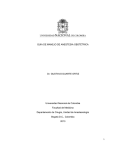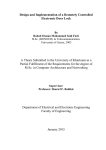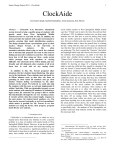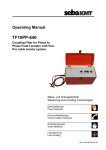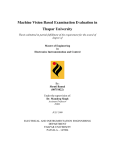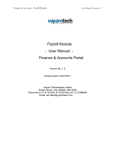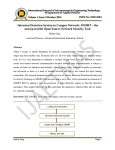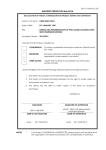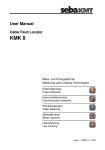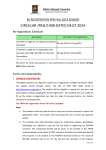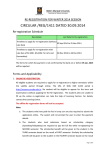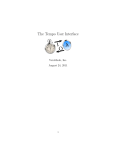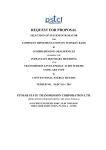Download A Graphical User Interface Framework for Detecting
Transcript
International Journal of Computer Applications (0975 – 8887)
Volume 55– No.13, October 2012
A Graphical User Interface Framework for Detecting
Intrusions using Bro IDS
Shaffali Gupta
Rachit Goel
M.Tech Scholar
Thapar University, Patiala
M.tech Scholar
Doon Valley, Karnal
ABSTRACT
Internet has transformed and greatly improved the way we do
business, the network and its associated technologies have
opened the door to an increasing number of threats from
which corporations must protect them. To protect the network,
Network Security is needed. To make network secure, an
Intrusion Detection System is needed. An intrusion is used to
monitor network traffic, check for suspicious activities and
notifies the system or network administrator. Many open
source tools are available for detecting intrusions in a
network. Most common of these are Snort and Bro .In this
paper, the main emphasis will be to explore Bro. However,
based upon CPU utilization and memory constraints,
performance analysis of Bro and Snort is done. Taking a
closer look at open source Network Intrusion Detection
System, there is a very powerful open source system that is
termed as Bro. It passively monitors network traffic and looks
for suspicious activity by comparing network traffic against
scripts. In this paper, various policy scripts written in Bro
language to filter out the network traffic will be discussed.
Also, a Graphical Interface called Bro GUI Framework is
designed to automate the creation and run of the policy
scripts.
Keywords
Analyzer, Event Handler, Policy scripts, sendmail client.
1. INTRODUCTION
Network security is a complicated subject, historically only
tackled by well-trained and experienced experts. However, as
more and more people become ``wired'', an increasing number
of people need to understand the basics of security in a
networked world [1]. To secure networks, two systems
extensively explored under IDS are: Snort and Bro. Snort is
small, lightweight open source IDS capable of performing
packet logging and real time traffic analysis on IP networks.
Snort shows some technical limitations that indicate that it is
not always an optimal solution. So, there is at least one other
very powerful open source system that is largely unknown:
termed as Bro. Bro is originated as a research system. It is
designed and developed by Vern Paxson at the International
Computer Science Institute in Berkeley, CA [2]. Bro monitors
network traffic and detects intrusion attempts based on the
traffic characteristics and content. By judiciously leveraging
packet filtering techniques, Bro is able to achieve the
performance necessary to do so while running on
commercially available PC hardware and thus can serve as a
cost effective means of monitoring a site’s Internet
connection. Bro is a signature-based IDS, meaning that it
attempts to match a signature to network traffic in order to
find the attack [3]. Bro also comes with its own language
which advanced users can utilize to program policy scripts.
Policy scripts allow network administrators to fine-tune their
Bro installation in order to specifically search out certain
types and patterns of traffic, and define them as malicious [4].
However, the policy scripts are few in number and there are
various types of traffic that are still not captured by Bro IDS.
Moreover, policy scripts that are executed to block, alert or
log information about network traffic are yet needed to be
explored. Much of the work has already been done to capture
and filter traffic of various network classes. The network
traffic of classes like SMTP, FTP is further needed to be
worked on. Currently, Bro biggest shortfall is that it only
report information to log files and does not have a Graphical
User Interface (GUI). Till now the traffic is captured by
typing the commands which is an overhead for users. So a
GUI framework is required that could capture traffic more
effectively and easily. Also, a framework is needed to
automate the creation of policy scripts and run those scripts to
capture and filter the network traffic.
2. Comparison of Bro and Snort IDS
Snort provides a very up-to-date, well documented and tested
set of rules but it is found that as the number of signature
increases, the Snort CPU utilization and memory usage
increases. To overcome this problem of Snort, Bro provides a
complete different architecture. The great feature of Bro is
that it can memorize the states of each flow, and can use it for
detecting malicious activities. Despite having several
dissimilarities, both are oriented towards high speed links.
Table 1 shows major differences between Snort and Bro.
Table 1. Comparison of IDS
Snort IDS
Bro IDS
Do not use layered approach.
Use Layered approach.
Rule matching engine is
more efficient.
Less efficient than snort.
To
detect
intrusions,
signatures are written.
Policy rules are defined.
Performance degrades as
number
of
signatures
increases.
Performance
degrade.
does
not
7
International Journal of Computer Applications (0975 – 8887)
Volume 55– No.13, October 2012
Packet missing rate is high.
Bro includes both signature
matching engine and an
application analysis scripting
language.
Highly documented.
Less documentation.
OUTPUT:
Snapshot 1: Filtered Traffic containing only SMTP
packets.
\\
3. Bro POLICY SCRIPTS
A live traffic consists of packets going through various
protocols like HTTP, TCP SMTP, DNS, ARP etc. In this
section various policy scripts are designed to filter out the
desired protocol packets from live captured traffic. In this
section, traffic of SMTP, HTTP, FTP, TCP protocol is filtered
and analyzed.
3.1 Script To Filter SMTP Packets From
Live Captured Traffic.
The live traffic consists of HTTP, TCP, FTP, DNS etc
protocol packets. To filter out the smtp packets from the live
traffic this script is written. Bro instantiates a smtp analyzer to
processes the traffic associated with the email service, coming
on port 25 providing the appropriate event handler is defined.
To capture the smtp packets, sendmail [5] client is used. The
script is written as:
smtp_sample.bro script:
@load weird
3.2 Script To Filter HTTP Packets From
Live Captured Traffic.
Generally, the live traffic consists of various protocol packets
like HTTP, TCP, FTP, DNS etc. To filter out the HTTP
packets from the live traffic this script is written. Bro
instantiates a http analyzer to processes the traffic associated
with the HTTP [6] protocol, coming on port 80 providing the
appropriate event handler is defined. The script is written as:
http_sample.bro script:
@load weird
@load alarm
@load http-body
global path: string;
redef ignore_checksums= T;
event http_request(c: connection, method: string,
original_URI: string, unescaped_URI: string, version: string)
@load alarm
{
@load smtp
global path: string;
print fmt ("IP: %s WITH PORT NO:%s IS TRYING TO
ACCESS HTTP PACKETS" ,c$id$orig_h ,c$id$orig_p);
redef ignore checksums= T;
}
event smtp_request(c: connection, is_orig: bool, command:
string, arg: string)
{
To get the filtered output, following set of command
are run at the terminal:
1. broctl install
print fmt ("IP: %s, WITH PORT NO: %s IS TRYING TO
ACCESS SMTP PACKETS", c$id$orig_h, c$id$orig_p);
2. bro –i eth0 http_sample.bro
OUTPUT:
}
To get the filtered output, following set of command
are run at the terminal:
1. broctl install
2. bro –i eth0 smtp_sample.bro
To get the smtp packets, sendmail client is run on terminal
by typing command as:
sendmail –v [email protected] < test.mail
Snapshot 2: Filtered Traffic containing only
HTTP packets.
3.3 Script To Filter TCP Packets From
Live Captured Traffic.
Generally, the live traffic consists of various protocol packets
like SMTP, HTTP, TCP, FTP, DNS etc. To filter out the
packets going through TCP [7] protocol, from the live traffic
this script is written. Bro instantiates a tcp analyzer to
processes the traffic associated with the TCP protocol
8
International Journal of Computer Applications (0975 – 8887)
Volume 55– No.13, October 2012
providing the appropriate event handler is defined. The script
is written as:
event bro_done()
{
tcp_sample.bro script:
@load weird
for ( h in hosts )
@load alarm
print h, hosts[h];
}
@load tcp
•
event tcp_packet(c: connection, is_orig: bool, flags: string,
seq: count, ack: count, len: count, payload: string)
{
To get the required output, following set of
command are run at the terminal:
1. broctl install
print fmt("IP : %s WITH PORT NO:%s IS TRYING TO
ACCESS TCP PACKETS" ,c$id$orig_h, c$id$orig_p);
2. bro –i eth0 count.bro
OUTPUT:
}
192.168.61.137
To get the filtered output, following set of command
are run at the terminal:
1. broctl install
12
Snapshot 4: Filtered Traffic containing count of
connections.
2. bro –i eth0 tcp_sample.bro
3.5 Script To Filter FTP Packets From
Live Captured Traffic.
OUTPUT:
Generally, the live traffic consists of various protocol packets
like SMTP, HTTP, TCP, FTP, DNS etc. To filter out the
packets going through FTP protocol, from the live traffic this
script is written. Bro instantiates a ftp analyzer to processes
the traffic associated with the FTP file transfer service. To
capture the ftp packets, vsftpd [8] client is installed on client
machine.The script is written as:
Snapshot 3: Filtered Traffic containing only
TCP packets.
ftp_sample.bro script:
@load weird
3.4 Script To Count The Number Of
Connections Established By Each Local
Host.
@load alarm
@load ftp
A sample script is written to count the number of connections
established by each local host. The script is written as:
redef ignore checksums= T;
event ftp_request (c: connection, command: string, arg:
string)
count.bro script:
@load weird
{
@load alarm
@load tcp
print fmt("IP ADDRESS: %s WITH PORT NO:%s IS TRYING
TO ACCESS FTP PACKETS”, c$id$orig_h ,c$id$orig_p);
global hosts: table[addr] of count &default=0;
}
event connection_established(c: connection)
To get the filtered output, following set of command
are run at the terminal:
1. broctl install
{
2. bro –i eth0 ftp_sample.bro
local orig = c$id$orig_h;
To get the ftp packets, vsftpd client is installed and
run on the client machine.
if ( ! is_local_addr(orig) )
return;
++hosts[orig];
}
9
International Journal of Computer Applications (0975 – 8887)
Volume 55– No.13, October 2012
OUTPUT:
Snapshot 5: Filtered Traffic containing only FTP
packets.
using Bro GUI Framework are saved in a file having .bro
extension. The live traffic is run on the scripts. The output is
the filtered traffic. The filtered output is shown on the screen
so that users can analyze it and also the filtered traffic is saved
in a file on the pre-decided path so that it can be examined for
future reference. Various Sections of GUI contain information
about bro and define sample scripts so that a user can
understand execution of policy scripts and Bro GUI
Framework in an easy manner. On starting the GUI, “start-up”
form as shown in Snapshot 7 is displayed.
3.6 Script To Display Source And
Destination Address Of Captured Traffic.
This script is used to display the IP address and port number
of the source and destination machines. The analyzer used is
http and event handler is http_header. The script is shown as:
ip_sample.bro script:
@load weird
@load alarm
@load http
global path: string;
redef ignore_checksums= T;
event http_header(c: connection, is_orig: bool, name: string,
value: string)
{
Snapshot 7: Start-up Form.
print fmt ("CONNECTION IS: %s: %s ->%s: %s",
c$id$orig_h, c$id$orig_p, c$id$resp_h, c$id$resp_p);
}
To get the filtered output, following set of command
are run at the terminal:
1. broctl install
2. bro –i eth0 ip_sample.bro
The Start-up form mainly consists of two menu bars named as
Bro Script and Read Me. These main modules are further
divided into menu items. The menu bar Bro Script is further
divided into two menu items namely Make Script and Run
Script. The menu bar Read Me is further divided into two
menu items called About Bro and User Manual while menu
bar Bro Script is divided into Make Script and Run Script
menu items.
OUTPUT:
Snapshot 6: Filtered Traffic containing source and
destination machine address.
4. INTRODUCTION OF BRO GUI
FRAMEWORK
Bro is a UNIX based Network Intrusion Detection System.
The shortfall is that there is no GUI Framework for Bro IDS.
The traffic is captured by using the commands which is an
overhead for user. So a GUI framework is required that could
capture traffic more effectively and easily. The “Bro GUI
Framework” is developed in JDK 1.7 environment. The input
to the Bro GUI Framework is live traffic. The scripts designed
Fig 1: Tree Hierarchy of Bro GUI Framework.
“About Bro IDS” Form contain details about Bro. Various
Sections contain features and design goals of Bro IDS. This
form helps a user to learn about Bro in an easy and efficient
manner.
10
International Journal of Computer Applications (0975 – 8887)
Volume 55– No.13, October 2012
Snapshot 8: About Bro IDS Form.
Snapshot 10: Make Script Form.
“User Manual” Form shows the various steps needed to run
the Bro GUI Framework. This form contains the series of
steps necessary to run the Framework. A sample script is
written to build the user understanding about the making of
scripts.
Now, the policy script created in “Make Script” form is
applied on live traffic in this form. To achieve this, shell script
containing a series of commands is written and saved. On
clicking the “START CAPTURING TRAFFIC” button, shell
script is run.
Snapshot 11: Capture Form
Snapshot 9: User Manual Form
4.1 Example To Demonstrate Working of
Bro GUI Framework
To start the process, “Make Script” Form as shown in
Snapshot 10 present under Bro Script menu bar is selected.
Various Combo box and check boxes present on this form
contain different arguments and event handlers necessary for
the creation of policy scripts. To make the desired script,
appropriate options are selected. All the data chosen from
these boxes is added to a file after concatenation to make the
script. After clicking on “Make Script!” button, policy script
will be saved in the on the pre-decided path and Capture form
will be displayed.
After clicking on “CLICK TO GO ON NEXT PAGE” button,
“Run Script” form as shown in Snapshot 12 will be displayed.
By default, all the options are set disabled on this form. After
reading the created script by system, appropriate option will
automatically set enabled. On clicking the “submit” button,
the required output will be shown in the text area. For
example, here filtered traffic containing only tcp packets is
displayed.
11
International Journal of Computer Applications (0975 – 8887)
Volume 55– No.13, October 2012
6. FUTURE WORK
Presently the traffic of SMTP, TCP, HTTP and FTP is
examined and filtered. The work can be enhanced to trace the
traffic of SSl, bit torrent and P2P. In this paper, scripts are
created that generate alerts on desired incoming network
packets. In future, scripts can be created that will used to
block the desired network traffic. The proposed GUI
framework can be further extended to report events to
database instead of log files so that data can be stored safely
for future reference.
7. REFERENCES
[1] Forrest S., Homeyr S. and Sommayaji A., “Computer
Immunology”, Communications of the ACM, vol. 40, no.
10, pp. 88- 96, October 1997.
[2] Paxson V., “Bro: A System for Detecting Network
Intruders in Real-Time”, in Proceedings of 7th USENIX
Security Symposium, pp. 2435-2463, December 1999.
Snapshot 12: Run Script Form.
5. CONCLUSION
Today network is very complex and whole world is focusing
on ease of use and functionality. Unfortunately security
policies and rules needed to govern these networks have not
progressed as rapidly. So there is huge need of detecting the
threats and intrusions as rapidly as possible. An intrusion
detection system is used to monitor network traffic, check for
suspicious activities and notifies the system or network
administrator. Bro is one of the most effective IDS which can
be used to detect these threats.
In this paper, new policy scripts are designed to filter out the
needed packets from traced traffic and generate alert on
desired incoming network packets. Policy scripts are written
to filter E-mail and File Transfer traffic going via SMTP and
FTP protocol respectively. These policy scripts display web
traffic sent on HTTP and TCP protocol after analyzing them.
These scripts help to know the source and destination address
of the captured traffic. Also a policy script is built to count the
number of established connections by each local host. A GUI
framework is integrated in Bro that analyzes and filters the
traced network traffic. It eliminates the need of writing the
commands at terminal and makes it easy for users to create
the scripts and run them on captured traffic.
[3] Sommer R., “BRO: An Open Source Network Intrusion
Detection System”, in Security, E-Learning, E-Services,
17 DFN- Arbeitstagung uber Kommunikationsnetze, vol.
44, Dusseldorf, Germany: Gesellschaft fur Informatik
(GI), 2004, pp. 273-288
[4] Sommer R., Slides on the Bro Network Intrusion
Detection System, Lawrence Berkeley National
Laboratory, Berkeley, CA, 2009.
[5] Allman E., Shapiro G. N. and Assmann C., “Sendmail
Installation and Operation guide”, US Patent 6865671,
6986037, October 2001.
[6] Hypertext
Transfer
Protocol,
Available
at:
http://en.wikipedia.org/wiki/Hypertext_Transfer_Protoco
l.
[7] Transmission
Control
Protocol,
Available
at:
http:en.wikipedia.org/wiki/Transmission_Control_Protoc
ol
[8] Natarajan R. (2010). 7 Steps for Linux vsftpd Install,
Configuration, Users Setup [Online]. Available at:
http://www.thegeekstuff.com/2010/11/vsftpd- setup.
.
12






